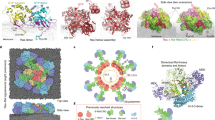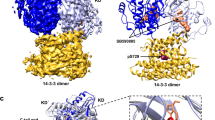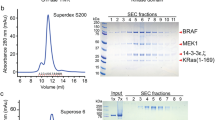Abstract
Growth factor receptor–binding proteins Grb7, Grb10 and Grb14 are adaptor proteins containing a Ras-associating (RA) domain, a pleckstrin-homology (PH) domain, a family-specific BPS (between PH and SH2) region and a C-terminal Src-homology-2 domain. Previous structural studies showed that the Grb14 BPS region binds as a pseudosubstrate inhibitor in the tyrosine kinase domain of the insulin receptor to suppress insulin signaling. Here we report the crystal structure of the RA and PH domains of Grb10 at 2.6-Å resolution. The structure reveals that these two domains, along with the intervening linker, form an integrated, dimeric structural unit. Biochemical studies demonstrated that Grb14 binds to activated Ras, which may serve as a timing mechanism for downregulation of insulin signaling. Our results illuminate the membrane-recruitment mechanisms not only of Grb7, Grb10 and Grb14 but also of MIG-10, Rap1-interacting adaptor molecule, lamellipodin and Pico, proteins involved in actin-cytoskeleton rearrangement that share a structurally related RA-PH tandem unit.
This is a preview of subscription content, access via your institution
Access options
Subscribe to this journal
Receive 12 print issues and online access
$189.00 per year
only $15.75 per issue
Buy this article
- Purchase on Springer Link
- Instant access to full article PDF
Prices may be subject to local taxes which are calculated during checkout






Similar content being viewed by others
Change history
22 September 2009
In the version of this article initially published, the Grp1 structure described in Figure 3c was incorrectly labeled Grb1. The error has been corrected in the HTML and PDF versions of the article.
References
Han, D.C., Shen, T.L. & Guan, J.L. The Grb7 family proteins: structure, interactions with other signaling molecules and potential cellular functions. Oncogene 20, 6315–6321 (2001).
Holt, L.J. & Siddle, K. Grb10 and Grb14: enigmatic regulators of insulin action—and more? Biochem. J. 388, 393–406 (2005).
Charalambous, M. et al. Disruption of the imprinted Grb10 gene leads to disproportionate overgrowth by an Igf2-independent mechanism. Proc. Natl. Acad. Sci. USA 100, 8292–8297 (2003).
Smith, F.M. et al. Mice with a disruption of the imprinted Grb10 gene exhibit altered body composition, glucose homeostasis, and insulin signaling during postnatal life. Mol. Cell. Biol. 27, 5871–5886 (2007).
Wang, L. et al. Peripheral disruption of the Grb10 gene enhances insulin signaling and sensitivity in vivo. Mol. Cell. Biol. 27, 6497–6505 (2007).
Shiura, H. et al. Meg1/Grb10 overexpression causes postnatal growth retardation and insulin resistance via negative modulation of the IGF1R and IR cascades. Biochem. Biophys. Res. Commun. 329, 909–916 (2005).
Cooney, G.J. et al. Improved glucose homeostasis and enhanced insulin signalling in Grb14-deficient mice. EMBO J. 23, 582–593 (2004).
Cariou, B. et al. Increased adipose tissue expression of Grb14 in several models of insulin resistance. FASEB J. 18, 965–967 (2004).
Rampersaud, E. et al. Identification of novel candidate genes for type 2 diabetes from a genome-wide association scan in the Old Order Amish: evidence for replication from diabetes-related quantitative traits and from independent populations. Diabetes 56, 3053–3062 (2007).
Depetris, R.S., Hu, J., Gimpelevich, I., Holt, L.J. & Hubbard, S.R. Structural basis for inhibition of the insulin receptor by the adaptor protein Grb14. Mol. Cell 20, 325–333 (2005).
Holt, L.J. & Daly, R.J. Adapter protein connections: the MRL and Grb7 protein families. Growth Factors 23, 193–201 (2005).
Manser, J., Roonprapunt, C. & Margolis, B. C. elegans cell migration gene mig-10 shares similarities with a family of SH2 domain proteins and acts cell nonautonomously in excretory canal development. Dev. Biol. 184, 150–164 (1997).
Lafuente, E.M. et al. RIAM, an Ena/VASP and Profilin ligand, interacts with Rap1-GTP and mediates Rap1-induced adhesion. Dev. Cell 7, 585–595 (2004).
Jenzora, A., Behrendt, B., Small, J.V., Wehland, J. & Stradal, T.E. PREL1 provides a link from Ras signalling to the actin cytoskeleton via Ena/VASP proteins. FEBS Lett. 579, 455–463 (2005).
Krause, M. et al. Lamellipodin, an Ena/VASP ligand, is implicated in the regulation of lamellipodial dynamics. Dev. Cell 7, 571–583 (2004).
Lyulcheva, E. et al. Drosophila Pico and its mammalian ortholog lamellipodin activate serum response factor and promote cell proliferation. Dev. Cell 15, 680–690 (2008).
Derewenda, Z.S. Rational protein crystallization by mutational surface engineering. Structure 12, 529–535 (2004).
Nassar, N. et al. The 2.2 crystal structure of the Ras-binding domain of the serine/threonine kinase c-Raf1 in complex with Rap1A and a GTP analogue. Nature 375, 554–560 (1995).
Huang, L., Weng, X., Hofer, F., Martin, G.S. & Kim, S.H. Three-dimensional structure of the Ras-interacting domain of RalGDS. Nat. Struct. Biol. 4, 609–615 (1997).
Ceccarelli, D.F. et al. Non-canonical interaction of phosphoinositides with pleckstrin homology domains of Tiam1 and ArhGAP9. J. Biol. Chem. 282, 13864–13874 (2007).
Lemmon, M.A. & Ferguson, K.M. Signal-dependent membrane targeting by pleckstrin homology (PH) domains. Biochem. J. 350, 1–18 (2000).
Hyvönen, M. et al. Structure of the binding site for inositol phosphates in a PH domain. EMBO J. 14, 4676–4685 (1995).
Ferguson, K.M. et al. Structural basis for discrimination of 3-phosphoinositides by pleckstrin homology domains. Mol. Cell 6, 373–384 (2000).
Lietzke, S.E. et al. Structural basis of 3-phosphoinositide recognition by pleckstrin homology domains. Mol. Cell 6, 385–394 (2000).
Thomas, C.C., Deak, M., Alessi, D.R. & van Aalten, D.M. High-resolution structure of the pleckstrin homology domain of protein kinase b/akt bound to phosphatidylinositol (3,4,5)-trisphosphate. Curr. Biol. 12, 1256–1262 (2002).
Rodriguez-Viciana, P., Sabatier, C. & McCormick, F. Signaling specificity by Ras family GTPases is determined by the full spectrum of effectors they regulate. Mol. Cell. Biol. 24, 4943–4954 (2004).
Huang, L., Hofer, F., Martin, G.S. & Kim, S.H. Structural basis for the interaction of Ras with RalGDS. Nat. Struct. Biol. 5, 422–426 (1998).
Elchebly, M. et al. Increased insulin sensitivity and obesity resistance in mice lacking the protein tyrosine phosphatase-1B gene. Science 283, 1544–1548 (1999).
Klaman, L.D. et al. Increased energy expenditure, decreased adiposity, and tissue-specific insulin sensitivity in protein-tyrosine phosphatase 1B-deficient mice. Mol. Cell. Biol. 20, 5479–5489 (2000).
Lemmon, M.A. Pleckstrin homology domains: not just for phosphoinositides. Biochem. Soc. Trans. 32, 707–711 (2004).
Stein, E.G., Ghirlando, R. & Hubbard, S.R. Structural basis for dimerization of the Grb10 Src homology 2 domain. Implications for ligand specificity. J. Biol. Chem. 278, 13257–13264 (2003).
Béréziat, V. et al. Inhibition of insulin receptor catalytic activity by the molecular adapter Grb14. J. Biol. Chem. 277, 4845–4852 (2002).
Quinn, C.C., Pfeil, D.S. & Wadsworth, W.G. CED-10/Rac1 mediates axon guidance by regulating the asymmetric distribution of MIG-10/lamellipodin. Curr. Biol. 18, 808–813 (2008).
Hu, J., Liu, J., Ghirlando, R., Saltiel, A.R. & Hubbard, S.R. Structural basis for recruitment of the adaptor protein APS to the activated insulin receptor. Mol. Cell 12, 1379–1389 (2003).
Otwinowski, Z. & Minor, W. Processing of X-ray diffraction data collected in oscillation mode. Methods Enzymol. 276, 307–326 (1997).
Terwilliger, T.C. & Berendzen, J. Automated MAD and MIR structure solution. Acta Crystallogr. D 55, 849–861 (1999).
Emsley, P. & Cowtan, K. Coot: model-building tools for molecular graphics. Acta Crystallogr. D 60, 2126–2132 (2004).
Brünger, A.T. et al. Crystallography & NMR system: a new software suite for macromolecular structure determination. Acta Crystallogr. D 54, 905–921 (1998).
Murshudov, G.N., Vagin, A.A. & Dodson, E.J. Refinement of macromolecular structures by the maximum-likelihood method. Acta Crystallogr. D 53, 240–255 (1997).
Acknowledgements
This work was supported by US National Institutes of Health grant DK052916 (to S.R.H.) We thank R. Ghirlando for sedimentation velocity measurements, M. Philips (New York University School of Medicine) for hemagglutinin-tagged Ras vectors and discussions, F. McCormick (University of California, San Francisco) for the GST-Ras and GST-Rap vectors, D. Lambright (University of Massachusetts Medical School) for the Grp1 PH domain construct, D. Ceccarelli for assistance in the fluorescence-polarization experiments, T. Miller for critical reading of the manuscript and N. Hiremath and J. Burrill for technical assistance. Beamline X4A at the National Synchrotron Light Source, Brookhaven National Laboratory, a Department of Energy facility, is supported by the New York Structural Biology Consortium.
Author information
Authors and Affiliations
Contributions
R.S.D. performed crystallographic studies, in-cell biochemical experiments and manuscript preparation; J.W. performed structure refinement, fluorescence-polarization assays, in-cell biochemical experiments and manuscript preparation; S.R.H. supervised the project and was the principal manuscript author.
Corresponding author
Supplementary information
Supplementary Text and Figures
Supplementary Figures 1–5 (PDF 2467 kb)
Rights and permissions
About this article
Cite this article
Depetris, R., Wu, J. & Hubbard, S. Structural and functional studies of the Ras-associating and pleckstrin-homology domains of Grb10 and Grb14. Nat Struct Mol Biol 16, 833–839 (2009). https://doi.org/10.1038/nsmb.1642
Received:
Accepted:
Published:
Issue Date:
DOI: https://doi.org/10.1038/nsmb.1642
This article is cited by
-
Inhibition of Grb14, a negative modulator of insulin signaling, improves glucose homeostasis without causing cardiac dysfunction
Scientific Reports (2020)
-
Effect of six type II diabetes susceptibility loci and an FTO variant on obesity in Pakistani subjects
European Journal of Human Genetics (2016)
-
Non-canonical regulation of phosphatidylinositol 3-kinase gamma isoform activity in retinal rod photoreceptor cells
Cell Communication and Signaling (2015)
-
Integrated RAS signaling defined by parallel NMR detection of effectors and regulators
Nature Chemical Biology (2014)
-
Crystal structure of Lamellipodin implicates diverse functions in actin polymerization and Ras signaling
Protein & Cell (2013)



